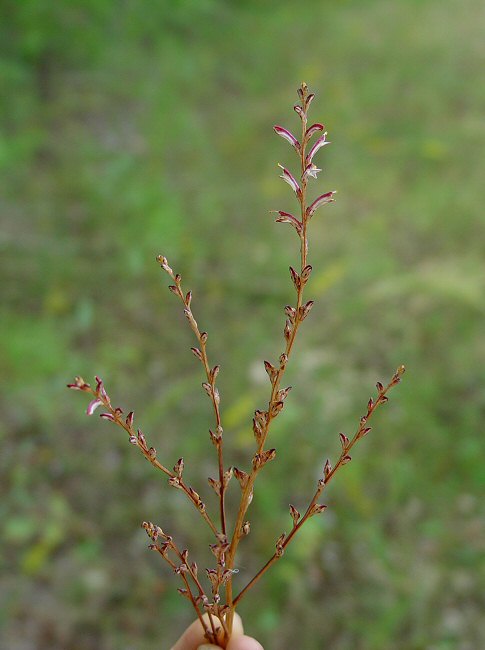Epifagus virginiana (L.) W.P.C. Barton
Beechdrops

Native
CC = 10
CW = 5
MOC = 4
SRank = S2
© DETenaglia
Epifagus virginiana (L.) W.P.C. BartonBeechdrops | |
 |
Native CC = 10 CW = 5 MOC = 4 SRank = S2 |
© DETenaglia |
|
Family - Orobanchaceae Habit - Annual holoparasitic forb, lacking chlorophyll, minutely glandular-hairy, the base enlarged into an irregular, tuberous structure, usually with yellow to orange, coralloid roots. Stems - Ascending to erect, to 40 cm, tan to brown, usually striped or tinged with purple or yellowish brown, usually with several ascending branches.
Leaves - Rudimentary scale-leaves 2-4 mm long, triangular to ovate. Inflorescences - Spikelike racemes, the flower stalks 1-3 mm long, the flowers subtended by 2 small bracteoles, these 1-2 mm long, triangular-ovate. Flowers of 2 types, the lower ones cleistogamous, the upper ones open-flowering but usually not producing fruits. Flowers - Calyces 3-5 mm long, brown to yellowish brown or reddish brown, 5-lobed, the lobes much shorter than the tube. Corollas of cleistogamous flowers 4-6 mm long, caplike and not opening, brown to purple. Corollas of open flowers 9-12 mm long, 4-lobed, white, usually with a pair of purple or reddish brown stripes, the tube somewhat curved or arching, the lobes shorter than the tube. Stamens 4, the filaments sparsely to moderately hairy, not or only slightly exserted, the anthers with 2 sacs, these slightly divergent, tapered to a minute, awnlike base, sparsely hairy, yellow. Style usually slightly exserted, the stigma capitate, slightly 2-lobed.
Fruits - Capsules 4-6 mm long, globose to broadly and somewhat obliquely ovoid, somewhat flattened, glabrous, dehiscing into 2 halves from the tip. Flowering - August - October. Habitat - Upland beech woods of Crowley's Ridge, usually on acidic substrate. Origin - Native to the U.S. Lookalikes - None. Other info. - This interesting little species is found in just a few southeast Missouri counties where Beech trees (Fagus grandifolia Ehrh.) occur. The plant is parasitic on the roots of the Beech. It produces no chlorophyll and thus lacks green coloration. The brown stems are hard to see against the fallen leaves on the forest floor. Because of this, the plant is often overlooked. Photographs taken at Mountain Longleaf National Wildlife Refuge, AL., 10-2-05 (DETenaglia). |